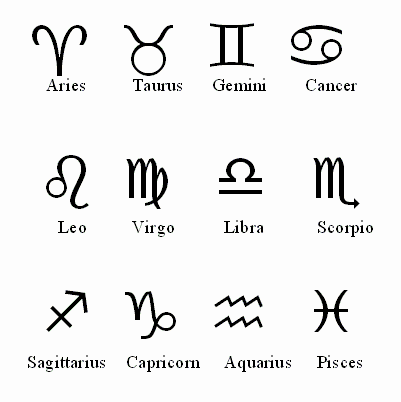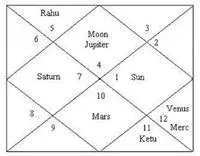12 Rasis of Vedic Astrology
Astrologers use the term ‘Rasi’ (Sign) to denote the position of an object in a particular place and direction and also to denote its position ill time. For instance, suppose a person is approaching you, ordinarily you would say that the person is coming to you, say from the southeast direction; but if you were an astrologer you would say that the person approaches you through a specific ‘Sign‘. This space around you is divided into a specified number of Signs, so that the location of any object is possible to be defined by stating the particular Sign corresponding to its position with respect to you. Similarly the time is also divided into a specified number of ‘Signs’, as change of time is realized with reference to the motion of the Sun (or other celestial bodies) relative to us.
In Astrology, the position of an object with respect to the observer is specified by an imaginary circle (ellipse) symmetrically surrounding the observer. This imaginary circle (ellipse) is divided into 12 equal angular parts radiating from the center (observer). Thus, each angular part would be 360 degrees divided by 12 = 30 degrees in extension. This angular section is called a ‘Rasi’ or Sign. Thus 1 Sign = 30 degrees. To fix the position of any object, one should also have a fixed object to get a reference point – for example a fixed star. From the line connecting the observer and the fixed object we mark out a 30 angular section ~ which is the first ‘Sign’ (Rasi). This is followed by the next eleven ‘Signs’.
Time also is divided to 12 Signs. For instance, the time reckoned from the Sunrise on a day till the next Sunrise (24 hours) also is divided into 12 angular sections, each being 30 degrees. In fact, the Sun appears to as if, it is making a relative elliptic motion around us during this period.
In this method of subdivision of space and time into 12 Signs, each one is given a specific name, starting from the first:
The whole zodiac of 360 degrees have been divided into 12 equal parts of each 30 degrees. Each part or house is also called rashi in vedic astrology. The rashi table with their Hindu name has been given below. The name of each zodiac sign with their symbol has also been given. Some astrology software uses these symbols instead of names. So, you must know these symbols also.
| S.No. | Rasi Name | Sanskrit Name | Symbol | Lord | Start | End |
|---|---|---|---|---|---|---|
| 1. | Aries | Mesha | Ar | Mars | 0°0’0“ | 29°50’50” |
| 2. | Taurus | Vrishabha / Vrisha | Ta | Venus | 30°0’0“ | 59°50’50” |
| 3. | Gemini | Mithuna | Ge | Mercury | 60°0’0“ | 89°50’50” |
| 4. | Cancer | Karka / Karkataka | Cn | Moon | 90°0’0“ | 119°50’50” |
| 5. | Leo | Simha | Le | Sun | 120°0’0“ | 149°50’50” |
| 6. | Virgo | Kanya | Vi | Mercury | 150°0’0“ | 179°50’50” |
| 7. | Libra | Tula / Thula | Li | Venus | 180°0’0“ | 209°50’50” |
| 8. | Scorpio | Vrischika | Sc | Mars | 210°0’0“ | 239°50’50” |
| 9. | Saggitarius | Dhanus / Dhanu | Sg | Jupiter | 240°0’0“ | 269°50’50” |
| 10. | Capricorn | Makara | Cp | Saturn | 270°0’0“ | 299°50’50” |
| 11. | Aquarius | Kumbha | Aq | Saturn | 300°0’0“ | 329°50’50” |
| 12. | Pisces | Meena | Pi | Jupiter | 330°0’0“ | 359°50’50” |
You must learn the name of Rasis and that too in the serial order as mentioned above in the table.
These 12 Signs correspond to the names of the 12 solar months from Mesha to Meena as considered in Indian Calendar and Panchaangas (Almanacs). This detail can he studied later. Those who do not know these names must learn them in the given order which may not be a very difficult task. These terms are to be often repeated in the following lessons.

Fixed objects like stars are said to occupy a particular Sign. A moving object (e:g. Planet) can be described as moving through the 12 Signs one after another. In children’s park, we see the Children seated in cradles and making circular movements. These circular movements take the children through all Rasi. Planets appear to revolve around us (the earth) through these Rasi and their position in the orbits (Paths) can be located in one of the 12 Signs.
We shall now learn how Sun, Moon, Planets and Stars (which are concerned with our life) are related to the 12 Signs. Though the movements of Celestial bodies, Sun, Moon, Planets, and Earth are complex; it would seem to us (on earth) that the Sun as well as the Planets and the Moon are revolving around us in an elliptic path. This imaginary elliptical broadband through which the celestial bodies seem to revolve is known in Astrological language as the Zodiac (Rasi chakra). The Sun’s path passes through the Zodiac.
There are 27 Constellations (group of stars) called NAKSHATHRA, remaining fixed beyond the Zodiac at definite positions. The Zodiac is supposed to be elliptical in shape and may be divided into 12 segments of equal angular extension (each angle being 30 degree).
The Sun takes about 360 days to move through the Zodiac from one point to return to the same point. Thus, the Sun takes 30 days (360/12) to pass through one Sign. Likewise the Moon takes 27 days to revolve around the whole Zodiac consisting of 12 Signs. Thus, the moon takes (27/12) 2\1. days to cross a Sign.
In the same way each Planet takes a fixed time to travel through a Sign. The Sun would take about 30 days from the date of entering into each Sign and after moving gradually through it finally to leave it and enter the next Sign. The interval between the entry of the Sun into a Sign and its exit is called a solar month. The solar months are named on the basis of the entry of Sun in each Rasi, passing through it and leaving it. When the Sun enters into a Mesha Sign the month Mesha begins and when it leaves the Mesha and enters into the next Sign (Vrishabha), Mesha month ends and the month Vrishabha begins. This transit takes about 30 days.
The 12 months are named after Sign in which the Sun moves in that month. Thus if the month is Vrishabha we can understand that the Sun would be occupying the Sign ‘Vrishabha’. If a child is born in the month ‘Karaka’ it means that at the time of birth the Sun is occupying the ‘Karaka’ Sign.
Likewise at the time of any event taking place in the world, each ‘Planet’ (including the Sun and Moon) would be occupying a definite Sign in the Zodiac. The same is true about the stars also. Thus at the time of our birth, the Sun, Moon, Planets and the Stars should be associated with definite locations of the Zodiac. The chart showing the positions (Signs) occupied by them at the time of our birth is called the Jathaka or Janmakundali or horoscope.
We have seen that the Zodiac is a belt of elliptic shape with a total of 360 degree spread and that it is divided into 12 parts, each of 30 degrees. We have also learnt that these parts are given different names -Mesha, Vrishabha etc. However, Astrologers instead of marking the Signs on a circular (or elliptical) chart, find it more convenient to denote the Planetary in the Zodiac on a square chart as given below:
Lord Ram Horoscope

The above sample horoscope is the horoscope of Lord Ram.
Summary of 12 Rasis of Vedic Astrology
This article briefly describes the zodiac signs, popularly known as Rashi in Vedic Astrology. One must learn the names of these signs in English and Hindi language and that too in serial order.